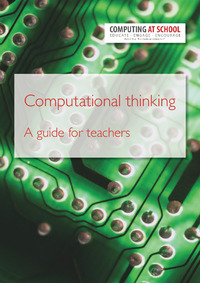Computational thinkingA guide for teachers
Andrew Csizmadia, Paul Curzon, Mark Dorling, Simon Humphreys, Thomas Ng, Cynthia Selby, John Woollard
Publikationsdatum:
|
 |
 Diese Seite wurde seit 3 Jahren inhaltlich nicht mehr aktualisiert.
Unter Umständen ist sie nicht mehr aktuell.
Diese Seite wurde seit 3 Jahren inhaltlich nicht mehr aktualisiert.
Unter Umständen ist sie nicht mehr aktuell.
 Zusammenfassungen
Zusammenfassungen
Computational thinking is an important life skill, which all pupils now need to develop. It is central to both living in and understanding our digitally enriched world. It is therefore a central concept in the new Computing Programme of Study. The framework presented here explains the concept and illustrates
it with effective learning experiences that develop the skills, as well as being a way of assessing their
development.
Von Andrew Csizmadia, Paul Curzon, Mark Dorling, Simon Humphreys, Thomas Ng, Cynthia Selby, John Woollard im Text Computational thinking (2015)  Dieser Text erwähnt ...
Dieser Text erwähnt ...
 Begriffe KB IB clear | computational thinkingcomputational thinking
, Informatikcomputer science
,  LehrerIn LehrerIn teacher
, teacher
,  Lernen Lernen learning learning
|
 Dieser Text erwähnt vermutlich nicht ...
Dieser Text erwähnt vermutlich nicht ... 
 Nicht erwähnte Begriffe | Bildung, Informatik-Didaktik, Informatik-Unterricht (Fachinformatik), Kinder, Schule, Unterricht |
 Tagcloud
Tagcloud
 Volltext dieses Dokuments
Volltext dieses Dokuments
 |  Computational thinking: Artikel als Volltext ( Computational thinking: Artikel als Volltext ( : :  , 4199 kByte; , 4199 kByte;  : :  2021-03-21) 2021-03-21) |
 Anderswo suchen
Anderswo suchen 
 Beat und dieser Text
Beat und dieser Text
Beat hat Dieser Text während seiner Zeit am Institut für Medien und Schule (IMS) ins Biblionetz aufgenommen. Beat besitzt kein physisches, aber ein digitales Exemplar. Eine digitale Version ist auf dem Internet verfügbar (s.o.). Aufgrund der wenigen Einträge im Biblionetz scheint er es nicht wirklich gelesen zu haben. Es gibt bisher auch nur wenige Objekte im Biblionetz, die dieses Werk zitieren.









 Biblionetz-History
Biblionetz-History